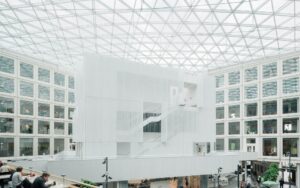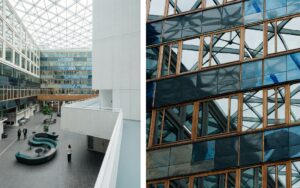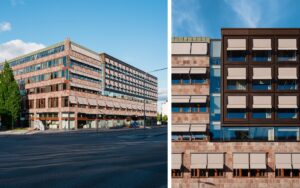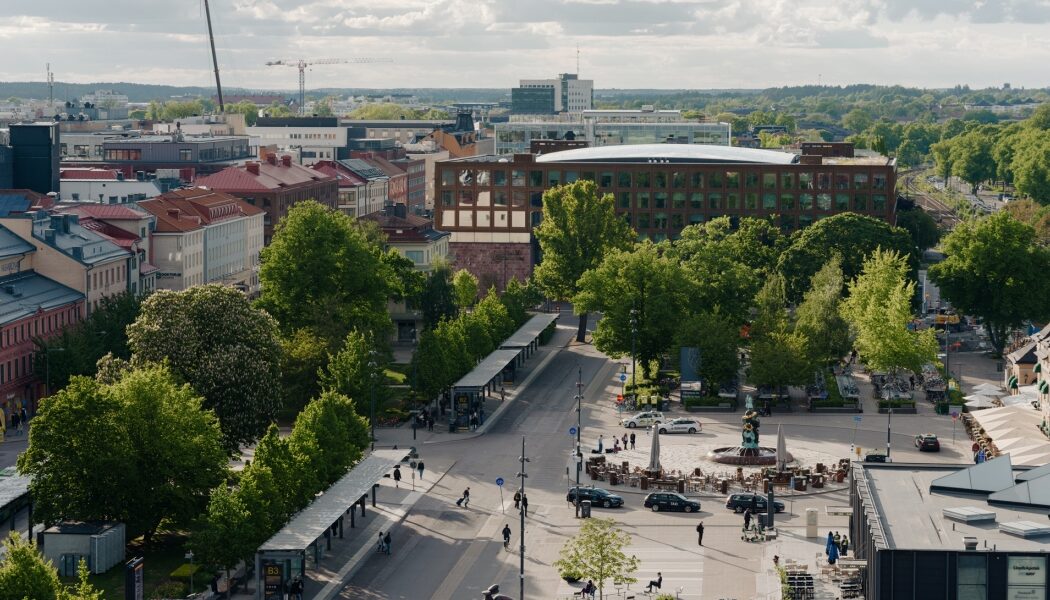Inspired by Kintsugi—the Japanese philosophy and art of repairing—the transformation of the Uppsala Town Hall visibly repairs and restores the old old town hall while adding new qualities through modern building techniques and technology.
Fifty-seven years after Uppsala Town Hall first opened in the city of Uppsala—which is north of Stockholm, the Swedish capital—it is finally fulfilling its original purpose.
 Uppsala Town Hall was recently awarded the Swedish Building of the Year 2022.
Uppsala Town Hall was recently awarded the Swedish Building of the Year 2022.
In collaboration with SLA and Tyréns, the architects at Henning Larsen designed an extensive transformation and extension of the Swedish town hall for Uppsala Municipality Arenas and Properties.
Like every architectural project, a transformation calls for a deep dive into the context to fully unfold the social, environmental, and historical conditions.
But, in addition, it also includes an exciting exploration into the work of others, investigating the past through the built environment. The design of the newly inaugurated Uppsala Town Hall is no exception to this.
 “A town hall is a physical manifestation of our democracy in the sense that it brings elected officials and citizens together. To reflect on this and at the same time build on the original vision of the town hall, we have designed a courtyard where citizens are invited right into the heart of the town hall. As architecture has evolved so has our technology, at Uppsala Town Hall we have used the latest solutions to turn a 1960’s building into a modern, super energy efficient building designed for the next 60 years of democracy,” says Jacob Kurek, Global Design Director at Henning Larsen.
“A town hall is a physical manifestation of our democracy in the sense that it brings elected officials and citizens together. To reflect on this and at the same time build on the original vision of the town hall, we have designed a courtyard where citizens are invited right into the heart of the town hall. As architecture has evolved so has our technology, at Uppsala Town Hall we have used the latest solutions to turn a 1960’s building into a modern, super energy efficient building designed for the next 60 years of democracy,” says Jacob Kurek, Global Design Director at Henning Larsen.
Unfinished Business
The late modernist design proposed by Erik and Tore Ahlsén had planned four five-story buildings congregating around a central outdoor courtyard. Construction, however, was met with financial struggles that concluded the project prematurely in 1964, and one of the buildings was not constructed in its entirety.
As a result, an L-shape was formed and the envisioned courtyard remained undefined, eventually becoming quite a dull parking lot.
Over the five decades that followed, the city tried several times to continue building, without success.
“Four connected buildings were originally planned, but only two were built. In fact, one of those was not built as planned but only had three stories. Nonetheless, they had prepared a structure underneath that was strong enough to continue construction in the future. They knew it would be difficult to do later, so they prepared. It’s just so thoroughly planned, it was quite incredible to have such a thoroughly planned basis to work from and update it to today’s standard’s both in terms of society and building regulations,” explains Per Ebbe Hansson, Lead Design Architect, Henning Larsen.
 The unrealized plan meant that its intended function was never quite fulfilled. Uppsala Town Hall never managed to accommodate all the municipal departments and offices as, over the decades, many of them dispersed throughout the city.
The unrealized plan meant that its intended function was never quite fulfilled. Uppsala Town Hall never managed to accommodate all the municipal departments and offices as, over the decades, many of them dispersed throughout the city.
Short of an assembly hall, the elected politicians would even gather periodically in the neighboring Concert Hall for discussions and meetings.
In short, Uppsala’s Town Hall never became the place it was intended to become.
Past, Present and Future Come Together
The journey into the construction of the Ahlsén brothers’ unfinished building sparked the idea of using the Japanese art of repairing pottery with gold, known as Kintsugi, as inspiration for connecting the original building with a new one.
“Transformation processes have a very different mindset than designing from new, but at the same time, it can produce exciting and unexpected results, pushing and challenging the new because you have the old architecture playing an active role, like another voice in the discussion. We wanted to add to the existing building in a way that highlight the existing and the new. That was when the idea of Kintsugi came up. We have simply used glass in stead of gold. As a result, past, present, and future come together in the transformed town hall,” says Per Ebbe Hansson.
Now open to the public, the new building carries the legacy of the old but boasts 14,000 new square meters to finally house all the municipality’s activities.
A 1500 m2 indoor courtyard covered with a striking cantilevered dome-shaped glass roof, weighing 700 tons, offers an inclusive space for residents, municipality staff, and public officials to gather, and a sculptural building located within the courtyard in which the municipal council chambers and assembly hall are located, the building can now fully reflect the democratic values that drive the activities it is home to.
All Images courtesy of Henning Larsen.

